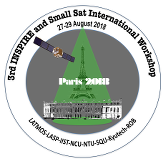MAJIS (Moons And Jupiter Imaging Spectrometer) is an instrument part of the science payload of the ESA L-Class mission JUICE (Jupiter ICy Moons Explorer) to be launched in 2022 and arrival at Jupiter in 2030 [1]. MAJIS will perform imaging spectroscopy to analyze the chemical compounds on the surfaces of the Galilean satellites, the characterization of their exospheres, the monitoring of peculiar aspects such as Io's and Europa torii and Io's volcanic activity, the study of Jupiter atmosphere, and the spectral characterization of the Jupiter system [2]. IASB-BIRA and ROB will contribute to MAJIS with the characterization of the VIS-NIR detectors, which includes the measurements of dark current, read-out noise, full-well capacity, conversion gain, persistence, linearity, defective pixels, quantum efficiency, fixed pattern noise, power dissipation, power consumption and operability.
Since some of the mentioned parameters require different illumination conditions, beam uniformity, exposure time, and/or data acquisition procedure for their measurement, three configurations have been established. The configuration 1 will be used to develop tests under dark conditions, the configuration 2 will assure light uniformity over the detector surface by means of an integrating sphere, and the configuration 3 will provide as close as possible the light beam that the detector should receive from MAJIS telescope using a focusing array.
The facility is divided in blocks. The entrance block includes a stable light source covering the spectral range of MAJIS followed by a variable aperture and a filter wheel, which can be remotely controlled. To assure uniformity on the beam, an integrating sphere could be used after the filter wheel in case the Signal-to-Noise Ratio is enough. The second block consists of a dual output monochromator with its own filter wheel and a PbS detector to monitor the stability of the light beam; the spectra obtained will be directed through an optical fiber to the last block. The final block receives the light beam from the optical fiber to the integrating sphere with a calibrated PbS reference detector and, depending on the configuration used, the integrating sphere could be connected directly to the vacuum chamber or to the focusing array.
The vacuum chamber will harbor the VIS-NIR Focal Plane Unit (FPU), which mainly contains the detector and its electronics, a movable cold plate, the electronic shutter and the cryocooler. The vacuum chamber will guarantee the cleanliness of the FPU and the necessary stable thermal conditions to characterize the HgCdTe detectors (<140K) working at a high-vacuum level in the order of 10$^{-6}$mbar. Moreover, the facility will provide a thermal control unit for the internal components of the FPU, the movable cold plate and the shutter, N2 flushing for the light path outside the vacuum chamber, the remote control of the spectrometer the filter wheel and the shutter, temperature and vacuum monitoring, and a security system to avoid conditions which could damage the detector and other critical components, besides the data processing software to analyze the detector response.
The design of the facility is developed through different analysis in optics, electronics, mechanics and software programming according to the requirements that shall be achieved in an iterative process to pass from the conceptual design to the preliminary design and finally to the detailed design. The facility should be validated at the beginning of 2019. This work describes the objectives and the foreseen designs of the calibration bench which will be used to characterize the MAJIS/JUICE VIS-NIR detectors at the IASB-BIRA laboratories, as well as some expected results.
References:
[1] Grasset, M. K., et al.: JUpiter ICy moons Explorer (JUICE): An ESA mission to orbit Ganymede and to characterise the Jupiter system, Planetary and Space Science, Vol. 78, pp. 1-21, 2013.
[2] Langevin, Y., and MAJIS Team: MAJIS (Moons And Jupiter Imaging Spectrometer) for JUICE: objectives for the Galilean satellites, European Planetary Science Congress, Vol. 8, pp. EPSC2013-548-1, 2013.
*This project acknowledges funding by the Belgian Science Policy Office (BELSPO) by PRODEX-11 Project Proposal: 'Characterization of JUICE/MAJIS VIS-NIR detectors'.*

